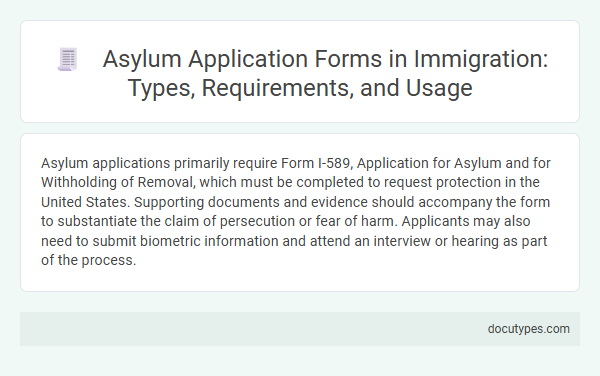Asylum applications primarily require Form I-589, Application for Asylum and for Withholding of Removal, which must be completed to request protection in the United States. Supporting documents and evidence should accompany the form to substantiate the claim of persecution or fear of harm. Applicants may also need to submit biometric information and attend an interview or hearing as part of the process.
Overview of Asylum Application Forms
| Form Name | Purpose | Key Features |
|---|---|---|
| Form I-589 | Application for Asylum and for Withholding of Removal | Used by individuals seeking asylum or withholding of removal in the United States. Requires detailed personal information, the basis for asylum claim, and supporting evidence. |
| Form EOIR-42 | Application for Protection under the Convention Against Torture | Filed with the Executive Office for Immigration Review alongside asylum applications when asylum is not granted, requesting protection against torture if removed. |
| Form I-765 | Application for Employment Authorization | Optional but commonly filed by asylum applicants to obtain work authorization while their asylum case is pending. |
| Form I-131 | Application for Travel Document | Allows asylum applicants to apply for Advance Parole to travel outside the U.S. while their asylum application is processed. |
Types of Asylum Application Forms
Asylum applications require specific forms depending on the type of asylum process you pursue. Different forms address various eligibility criteria and procedural steps involved in seeking protection.
- Form I-589, Application for Asylum and for Withholding of Removal - The primary form used to apply for asylum within the United States.
- Form EOIR-42B, Application for Cancellation of Removal and Adjustment of Status for Certain Nonpermanent Residents - Used in immigration court for relief including asylum under certain conditions.
- Form I-765, Application for Employment Authorization - Filed by asylum applicants to request permission to work while their asylum case is pending.
Key Requirements for Asylum Forms
Asylum applications require specific forms that collect detailed personal information and the basis of the asylum claim. The primary form used is Form I-589, Application for Asylum and for Withholding of Removal.
Key requirements for asylum forms include providing a thorough account of persecution faced or feared, supporting evidence, and accurate biographical details. The application must be submitted within one year of arrival in the United States unless qualifying exceptions apply. Legal representation is recommended to ensure proper completion and submission of the forms.
Step-by-Step Guide to Completing Asylum Forms
Asylum applications require specific forms to initiate and process your request for protection. Knowing which forms to use helps ensure a smooth application process.
- Form I-589 - The primary form used to apply for asylum and withholding of removal in the United States.
- Form G-28 - Used to notify U.S. Citizenship and Immigration Services (USCIS) that you have an attorney or accredited representative.
- Supporting Documentation - Includes personal statements, evidence of persecution, and identity documents to support your asylum claim.
Essential Documents for Asylum Application
Asylum applications require specific forms to initiate the process, with Form I-589, Application for Asylum and for Withholding of Removal, being the primary document. This form collects essential personal information and the basis of the asylum claim.
Supporting documents include identity proofs, evidence of persecution, and any country condition reports that validate the asylum seeker's claims. Accurate and complete submission of these forms and documents is crucial for successful processing.
Common Mistakes in Asylum Form Submission
Asylum applications primarily require the submission of Form I-589, the Application for Asylum and for Withholding of Removal. This form collects detailed information about the applicant's identity, reasons for seeking asylum, and any past persecution experienced.
Common mistakes in asylum form submission include incomplete or inconsistent information, which can lead to delays or denials. Applicants often neglect to provide supporting evidence or fail to sign and date the form properly.
Filing Deadlines and Processing Times
Asylum applications require specific forms, with strict filing deadlines and variable processing times. Understanding these forms and timelines is crucial for a successful application.
- Form I-589 - The primary application for asylum in the United States, it must be filed within one year of arrival unless exceptional circumstances apply.
- Form I-765 - Employment Authorization Document application available to asylum applicants after 150 days of pending asylum claims without delays caused by the applicant.
- Filing Deadlines - Missing the one-year filing deadline can disqualify applicants unless they demonstrate changed or extraordinary circumstances.
Processing times for asylum applications vary widely, ranging from several months to years depending on caseload and jurisdiction.
Legal Support for Asylum Applicants
What types of forms are used for asylum applications? The primary form is Form I-589, Application for Asylum and for Withholding of Removal. Legal support often involves assistance in accurately completing this form and preparing supporting evidence to strengthen your case.
Frequently Asked Questions on Asylum Forms
Asylum applications in the United States commonly require Form I-589, known as the Application for Asylum and for Withholding of Removal. This form collects detailed information about the applicant's background, reasons for seeking asylum, and any fear of persecution if returned to their home country. Applicants must submit Form I-589 within one year of their arrival to maintain eligibility for asylum consideration.
Many frequently asked questions focus on the completion and submission of Form I-589, including whether legal representation is necessary and how to handle supplementary evidence. The form does not have a filing fee, making it accessible to eligible applicants. Timely and accurate submission is critical to prevent denial based on procedural issues.
Other related forms include Form I-765, Application for Employment Authorization, which asylum seekers can file 150 days after their asylum application is pending. Clarifications on how to update address changes or report status changes are often addressed through Form AR-11. Understanding these forms streamlines the asylum process and aids applicants in complying with legal requirements.
What Types of Forms Are Used for Asylum Applications? Infographic

